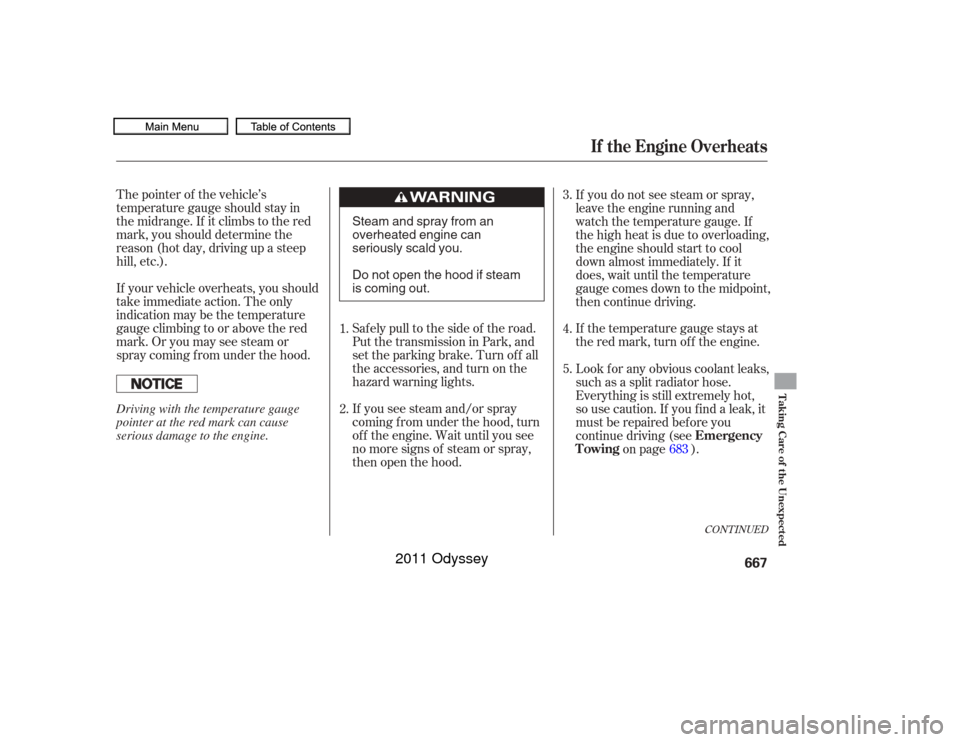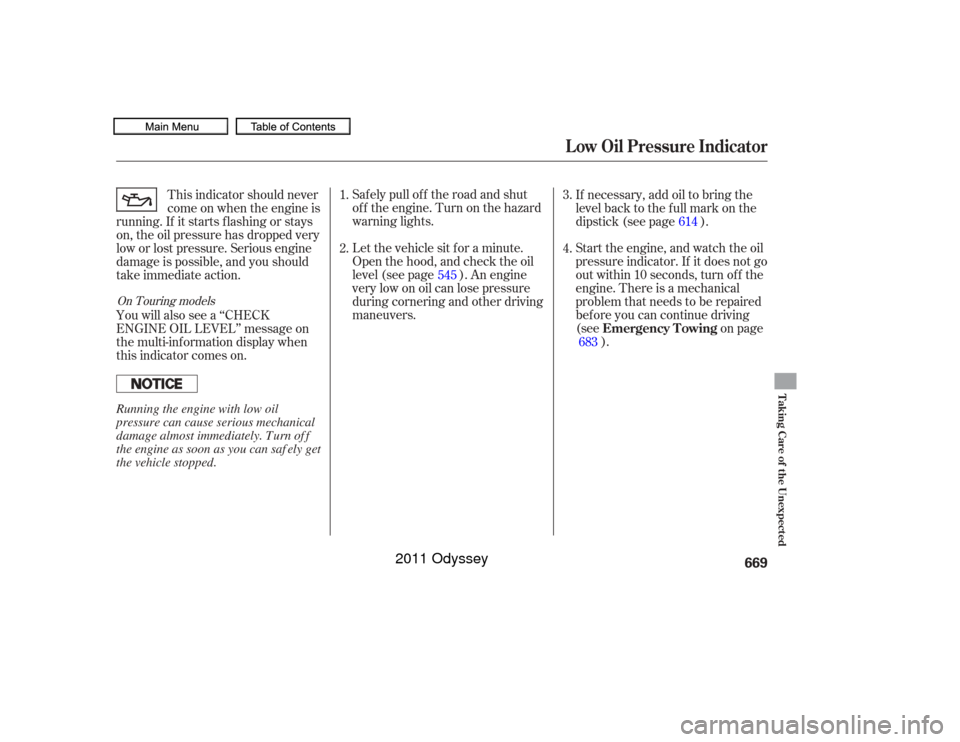Page 668 of 722

�´�´
CONT INUED
Although this seems like a simple
procedure, you should take several
precautions.
You cannot start your vehicle by
pushing or pulling it. The numbers in the illustration
show you the order to connect the
jumper cables.
Open the hood, and check the
physical condition of the battery.
In very cold weather, check the
condition of the electrolyte. If it
seems slushy or f rozen, do not try
jump starting until it thaws.
Remove the upper part of the air
intake duct (see page ).
Connect one jumper cable to the
positive ( ) terminal on your
vehicle’s battery. Connect the
other end to the positive ( )
terminal on the booster battery.
Turn of f all electrical accessories:
heater, A/C, climate control, audio
system, lights, etc. Put the
transmission in Park, and set the
parking brake.
1.
2.
3.
4.
626
To Jump Start Your Vehicle:
Jump Starting
Taking Care of the Unexpected
665
BOOSTER
BATTERY
A battery can explode if you do
not follow the correct procedure,
seriously injuring anyone
nearby.
Keep all sparks, open flames,
and smoking materials away
from the battery. If a battery sits in extreme cold, the
electrolyte inside can f reeze.
Attempting to jump start with a f rozen
battery can cause it to rupture.
10/07/17 11:03:15 31TK8600_670
2011 Odyssey
Page 670 of 722

The pointer of the vehicle’s
temperature gauge should stay in
the midrange. If it climbs to the red
mark, you should determine the
reason (hot day, driving up a steep
hill, etc.).
If your vehicle overheats, you should
take immediate action. The only
indication may be the temperature
gauge climbing to or above the red
mark. Or you may see steam or
spray coming f rom under the hood.If you see steam and/or spray
coming f rom under the hood, turn
of f the engine. Wait until you see
no more signs of steam or spray,
then open the hood.If the temperature gauge stays at
the red mark, turn off the engine.
Saf ely pull to the side of the road.
Put the transmission in Park, and
set the parking brake. Turn of f all
the accessories, and turn on the
hazard warning lights. If you do not see steam or spray,
leave the engine running and
watch the temperature gauge. If
the high heat is due to overloading,
the engine should start to cool
down almost immediately. If it
does, wait until the temperature
gauge comes down to the midpoint,
then continue driving.
Look f or any obvious coolant leaks,
such as a split radiator hose.
Everything is still extremely hot,
so use caution. If you f ind a leak, it
must be repaired bef ore you
continue driving (see
on page ).
1.
2. 3.
4.
5.
683
CONT INUED
If theEngineOverheats
Emergency
Towing
Taking Care of the Unexpected
667
Steam and spray from an
overheated engine can
seriously scald you.
Do not open the hood if steam
is coming out.
Driving with the temperature gauge
pointer at the red mark can cause
serious damage to the engine.
10/07/17 11:03:30 31TK8600_672
2011 Odyssey
Page 672 of 722

Let the vehicle sit f or a minute.
Open the hood, and check the oil
level (see page ). An engine
very low on oil can lose pressure
during cornering and other driving
maneuvers. Saf ely pull of f the road and shut
of f the engine. Turn on the hazard
warning lights.If necessary, add oil to bring the
level back to the full mark on the
dipstick (see page ).
Start the engine, and watch the oil
pressure indicator. If it does not go
outwithin10seconds,turnoff the
engine. There is a mechanical
problem that needs to be repaired
bef ore you can continue driving
(see
on page
).
This indicator should never
come on when the engine is
running. If it starts f lashing or stays
on, the oil pressure has dropped very
low or lost pressure. Serious engine
damage is possible, and you should
take immediate action.
You will also see a ‘‘CHECK
ENGINE OIL LEVEL’’ message on
the multi-information display when
this indicator comes on. 1.
2.
3.
4.
614
683
545
On Touring models
Emergency T owing
L ow Oil Pressure Indicator
Taking Care of the Unexpected
669
Running the engine with low oil
pressure can cause serious mechanical
damage almost immediately. Turn of f
the engine as soon as you can saf ely get
the vehicle stopped.
10/07/17 11:03:44 31TK8600_674
2011 Odyssey
Page 677 of 722
�µ
The primary under-hood f use box is
locatedonthepassenger’sside.The
secondary f use box is located next to
the battery.
To open each under-hood f use box,
pushthetabsasshown. If something electrical in your
vehicle stops working, the first thing
youshouldcheckforisablownfuse.
Determine f rom the chart on pages
, or the diagram on the
f use box lid or the f use label, which
f use or f uses control that component.
Check those f uses f irst, but check all
the f uses bef ore deciding that a
blown f use is not the cause. Replace
any blown fuses and check if the
device works.
Turn the ignition switch to the
LOCK (0) position. Make sure the
headlights and all other
accessories are of f .
Remove the cover f rom the f use
box.
1.
2. 678 682
Except the interior f use box on the
driver’s side
Fuses
Checking and Replacing Fuses
674
TAB
TAB
UNDER-HOOD (Primary)
UNDER-HOOD (Secondary)
10/07/17 11:04:22 31TK8600_679
2011 Odyssey
Page 715 of 722

CONT INUED
.................
Jacking up the Vehicle . 657
.......................................
Jack, Tire .656
................................
Jump Starting .665
................................................
Keys .144
.......................
Label, Certif ication .686
...............
Lane Change, Signaling . 136
..................
Lap/Shoulder Belts . 15,21
...........
LATCH Anchorage System . 46
....................
Light Control Switch .213
...
Identif ication Number, Vehicle . 686
Ignition ............................................
Keys .144
.........................................
Switch .147
............
Timing Control System . 698
......................
Immobilizer System .145
.........
Important Safety Precautions . 6
...................................
Indicators .63, 64
......
ABS (Anti-lock Brake) . 68,568
Brake (Parking and Brake ...........................
System) .67, 672
................
Charging System . 66,670
.............................
Cruise Control .75
DRL (Daytime Running .....................................
Lights) .73
Indicators .....................................
Fog Light .73
.............................
Fuel Economy .75
...................................
High Beam .73 .......
Key (Immobilizer System) . 69
.....................................
Lights On .73
......................................
Low Fuel .74
................
Low Oil Pressure . 66, 669
......
Low Tire Pressure . 71,572, 575
.............
Maintenance Minder . 599
.....................
Side Airbag Of f .33, 68
.........................................
SRS .32, 67
.........................
System Message .76
...........................
TPMS .72, 573, 575
Turn Signal and Hazard ...................................
Warning .72
Vehicle Stability Assist ...............
(VSA
) System . 69,570
............................
VSA Activation .69
..............................
Washer Level .74
..................
Individual Map Lights . 214
...............................
Inf ant Restraint .41
......................................
Inf ant Seats .41
......
LATCH Anchorage System . 46
...........................
Lower Anchors .46
..........
Tether Anchorage Points . 52
...................
Inf lation, Proper Tire . 643
.................................
Inside Mirror .197
.............................
Inspection, Tire .644
......................
Instrument Panel .4, 134 ......
Instrument Panel Brightness . 140
....................
Integrated Sunshade .205
...............................
Interior Lights .213
........................................
Introduction .i
.......................................
iPod
. 286, 383
HomeLink
Universal
................................
Transceiver .483
.......................
Hood, Opening the .544
...........................................
Horn .4,134
Index
J
K
L
I
INDEX
V
TM
10/07/17 11:08:53 31TK8600_718
2011 Odyssey